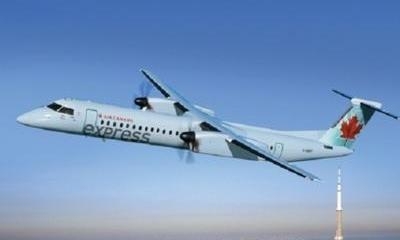Fri, Aug 11, 2017
Crew Experienced Temporary Difficulty With Aircraft Control At Mont-Joli Airport, Quebec
According to a Transportation Safety Board of Canada (TSB) investigation report (A16Q0020), a combination of moderate turbulence and wind shear contributed to the temporary difficulty with aircraft control effectiveness encountered by the flight crew while on approach at Mont-Joli Airport, Quebec, in February 2016. There were no injuries and no damage to the aircraft.

On 3 February 2016, a Jazz Aviation LP de Havilland DHC-8-102 was operating as flight JZA8964 from Montréal/Pierre Elliott Trudeau International Airport, Quebec, to Mont-Joli Airport, Quebec, with 24 passengers and three crew members on board. After being cleared for an approach, and while descending through 2480 feet above sea level with the landing gear down, the flight encountered moderate turbulence. This resulted in an abrupt increase in airspeed, which exceeded the maximum permissible airspeed with the landing gear extended. The pilot disconnected the autopilot and immediately levelled off the aircraft to reduce the airspeed. The pilot then experienced a temporary difficulty with aircraft control, but was able to maintain the approach profile and carry out the landing with no further difficulty.
The investigation determined that the airspeed increased abruptly when the aircraft encountered significant increased performance shear while flying out of a low-level jet with the autopilot engaged in vertical speed mode. A low-level jet is a narrow zone of strong winds in the lower levels of the atmosphere. The combination of turbulence and shear contributed to the temporary difficulty with aircraft control on approach.
After landing, the pilot reported the occurrence to the company but it was only reported to the TSB six days later. If reportable occurrences are not reported to the TSB in a timely manner, perishable information may be lost, which could preclude the identification and communication of safety deficiencies to advance transportation safety.
(Source: TSB news release. Image from file)
More News
Aero Linx: Model Aeronautical Association of Australia MAAA clubs are about fun flying, camaraderie and community. For over 75 years, the MAAA has been Australia’s largest fl>[...]
Touchdown Zone Lighting Two rows of transverse light bars located symmetrically about the runway centerline normally at 100 foot intervals. The basic system extends 3,000 feet alon>[...]
“Discovery and innovation are central to our mission at Virgin Galactic. We’re excited to build on our successful record of facilitating scientific experiments in subor>[...]
How To Get A Story On Aero-TV News/Feature Programming How do I submit a story idea or lead to Aero-TV? If you would like to submit a story idea or lead, please contact Jim Campbel>[...]
Student Pilot Reported That During Rotation, “All Of A Sudden The Back Of The Plane Kicked To The Right..." Analysis: The student pilot reported that during rotation, “>[...]
 ANN's Daily Aero-Linx (05.02.24)
ANN's Daily Aero-Linx (05.02.24) ANN's Daily Aero-Term (05.02.24): Touchdown Zone Lighting
ANN's Daily Aero-Term (05.02.24): Touchdown Zone Lighting Aero-News: Quote of the Day (05.02.24)
Aero-News: Quote of the Day (05.02.24) ANN FAQ: Contributing To Aero-TV
ANN FAQ: Contributing To Aero-TV NTSB Final Report: Cirrus Design Corp SR20
NTSB Final Report: Cirrus Design Corp SR20



